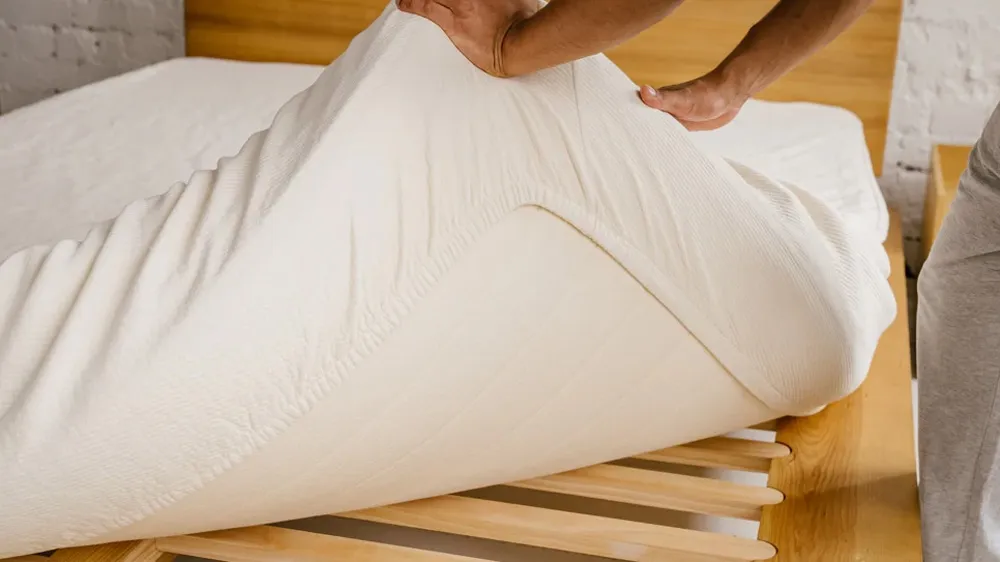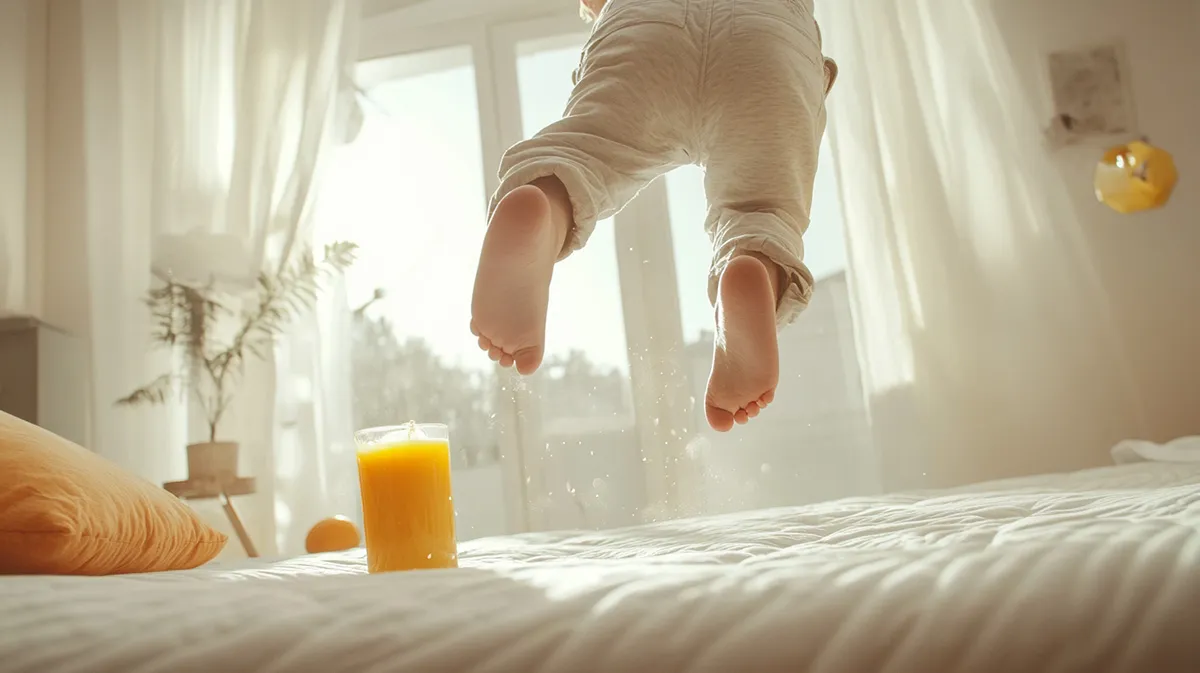Kids Mattress Protector – Everything You Need to Know
Your child will spend thousands of hours on their mattress during crucial growth years. While choosing the perfect children's mattress is essential, a quality kids mattress protector is also important. It's more than just a shield against spills and accidents—it's a barrier that helps protect your child from allergens and dust mites that could impact their developing immune system.
Beyond just protection, a high-quality kids mattress protector offers key benefits: It safeguards your child's mattress from moisture, stains, and bacteria while enhancing airflow. Like other bedding products, natural materials like organic cotton, wool, bamboo, or Tencel provide superior breathability and durability without harmful chemicals. Among these options, wool stands out for its excellent temperature regulation—perfect for Australia's climate.
Even if your mattress already has a zip cover, investing in a good mattress protector is still essential, especially for young children who need extra protection during their early years.
Recommended kids mattress protectors in Australia
Our ratings and recommendations remain neutral, based strictly on design quality, price value, and materials used to ensure the best mattress protector for your child's specific needs. We encourage you to read the complete article to determine which protector best suits your kid’s stage of development—the requirements of a 5-year-old differ significantly from those of a child entering adolescence.
Quokka Beds
Editor’s ChoiceOrganic Cotton Mattress Protector
Premium GOTS-certified organic cotton (245 GSM) is paired with non-toxic TPU waterproofing (without synthetic polyurethane). Deep elastic gussets fit mattresses up to 30cm thick. The breathable design regulates temperature while blocking moisture and allergens. It is perfect for children of all ages.
- Cover:100% Organic Cotton
- Waterproof:TPU (Non-toxic)*
- Wadding:100% Organic Cotton
- Certification:GOTS
Peace Lily
100% Organic Cotton Mattress Protector
Luxurious 350 GSM organic cotton quilted with 380 GSM wadding for superior absorption and breathability. It is one of the few protectors without TPU, as its exceptional thickness naturally blocks moisture. Handcrafted with elegant quilting and deep pockets, providing natural comfort for any kid.
- Cover:100% Organic Cotton
- Waterproof:No waterproofing
- Wadding:100% Organic Cotton
- Certification:GOTS
The Natural Bedding Company
Best ValueTencel Jersey Mattress Protector
Made from premium eucalyptus-based Tencel®, this breathable, hypoallergenic protector has been clinically tested. It features non-toxic TPU for waterproofing while blocking bacteria and allergens. The fitted design ensures easy care. This protector is ideal for older children who have outgrown the bedwetting stage.
- Cover:Tencel® (Eucalyptus)
- Waterproof:TPU (Miracle Membrane)*
- Wadding:Not padded
- Certification:OEKO-TEX
Sheet Society
Waterproof Cotton Kids Mattress Protector
This breathable, hypoallergenic protector has a 100% cotton outer, fill, and waterproof TPU backing. Its quilted wave design enhances comfort, and the sides are deep-fitted for a secure fit. This protector is OEKO-TEX certified, chemical-free, and budget-friendly. It is perfect for children of all ages, especially during toilet training.
- Cover:100% Cotton
- Waterproof:TPU
- Wadding:100% Cotton
- Certification:OEKO-TEX
Eco Kids
Bamboo Mattress Protector
Soft and breathable Australia-made protector, blending 70% bamboo viscose with 30% cotton. The TPU waterproof layer effectively blocks spills while maintaining comfort. The bamboo offers natural properties that prevent dust mites, mold, and bacteria, recognised by the National Asthma Council.
- Cover:70% Bamboo, 30% Cotton
- Waterproof:TPU (Miracle Layer)
- Wadding:Not padded
- Certification:Asthma Council
Is a Waterproof Protector Really Necessary?
An effective mattress protector doesn't always need to be labelled "waterproof." Quality natural materials like organic cotton quilted with wool provide sufficient protection against moderate accidents while maintaining essential breathability for comfortable sleep.
Think of a natural fibre protector as a premium kitchen sponge—it quickly absorbs spills, preventing liquid spread, without staying soggy. This absorbent barrier catches moisture before it reaches your mattress while allowing air circulation to maintain a comfortable sleep environment.
Should I choose a TPU waterproof protector?
When selecting a waterproof kid mattress protector, look beyond marketing claims to examine the actual waterproof material. Currently, TPU (thermoplastic polyurethane) represents the best balance of protection and safety available in the Australian market.
These protectors create an effective moisture barrier while maintaining flexibility and breathability. Premium TPU is free from harmful PVC and plasticisers, making it a safer choice for children's bedding.
However, as a petroleum-based product, quality varies significantly between manufacturers. Always verify OEKO-TEX or equivalent certifications to ensure compliance with strict health and safety standards. That is why many brands use standard controlled TPU like “Miracle Layer” or “Miracle Membrane.”
For children with nighttime accidents, certified TPU protectors remain the most reliable solution. As your child grows and accidents become less frequent, you can transition to highly absorbent natural non-toxic materials like organic cotton (with GSM of at least 250+) for a chemical-free, breathable alternative that still offers dependable moisture protection.
Beware of Uncertified Alternatives: some manufacturers offer other waterproof solutions. However, be wary of mattress protectors claiming to be waterproof without mentioning TPU or displaying certification. These products often use alternatives like PVC (polyvinyl chloride), which may contain harmful phthalates and other chemicals that pose risks to children's health.
Why your child needs a mattress protector
Let’s face it—kids are unpredictable, especially during sleep. From midnight accidents to night sweats in the heat of Australian summers, their mattress endures daily challenges that can impact its lifespan and sleep quality.
Children naturally sweat more than adults, especially in warm climates, and this excess moisture doesn’t just disappear—it seeps into the mattress, creating the perfect breeding ground for bacteria and odours.
Over time, even the cleanest bedrooms accumulate dust mites and allergens, which can trigger allergies or respiratory issues in sensitive children. A good kid’s mattress protector acts as a first line of defence, keeping their sleep space fresh while significantly extending the life of your mattress investment. Instead of facing an early replacement, you’ll ensure your child enjoys a consistently clean, healthy, and comfortable sleep surface.
The 4 most important features of a kid’s mattress protector
- Breathability: your child's protector should encourage airflow, not trap heat. Natural fibres like cotton, wool, and bamboo let your child's skin breathe while preventing a sweaty, plastic-wrapped feeling.
- Naturally Hypoallergenic: skip the chemical treatments. Natural materials protect against allergens without exposing your child to synthetic additives that could irritate their skin.
- Effective Moisture Control: a high-quality protector blocks spills and accidents without the crinkly plastic feel. Silent, discreet, and protective—it lets everyone sleep undisturbed.
- Durable Design: not all fabric thickness is equal. A quality protector features dense quilting (250GSM+) and multiple protective layers that maintain their shape and function even after frequent washing.

Choosing the right materials for your kid's mattress protector
Your child's body undergoes remarkable development during the crucial years from infancy through adolescence. Their immune system strengthens, their respiratory system matures, and their hormonal balance constantly adjusts.
While a polyester protector may seem cost-effective, its short 1-2 year lifespan makes it a false economy compared to the decade-long durability of natural materials. More importantly, synthetic protectors can release VOCs (Volatile Organic Compounds), exposing your child to potentially harmful chemicals during their most crucial developmental years.
That’s why choosing the right children’s mattress protector isn’t just about durability—it’s about creating the healthiest sleep environment to support your child’s growth and development.
Best Materials
- Organic Cotton: nature's premium choice, offering exceptional breathability and lasting up to 10 years with proper care.
- Merino Wool: Australia's super-material. Naturally temperature-regulating, moisture-wicking, and antimicrobial, keeping kids cool in summer and warm in winter.
- Bamboo: a sustainable choice that's naturally antibacterial and incredibly absorbent. Bamboo fabric can absorb up to three times more moisture than cotton.
- Tencel: a modern, eco-friendly fibre offering exceptional temperature regulation and silky smoothness.
Materials to Avoid
- Polyester: a budget-friendly but low-quality option. It traps heat, deteriorates within 1-2 years, and releases microplastics with every wash.
- PVC/Vinyl: often marketed as "waterproof," these materials crinkle loudly, trap heat, and may release harmful chemicals over time.
A Note on Australian Climate: Our unique climate demands smart material choices. Natural fibres like cotton, bamboo, and Tencel aren't just marketing buzzwords—they're particularly well-suited to handling both scorching summers and cool winters.
Even though your child isn't sleeping directly on the protector, its material significantly affects how heat and moisture move through their sleep environment. In Queensland's humidity or Melbourne's variable weather, these natural materials help maintain a consistently comfortable sleep temperature.
Cleaning and care: Keeping your child's mattress protector fresh
The proper cleaning routine can significantly extend your protector's life while ensuring a healthy sleep environment for your child. For young children aged 3-8 years, plan to wash their mattress protector every 1-2 weeks. Having two protectors on hand is a smart approach, especially during toilet training or if night accidents occur - this way, you'll always have a clean backup ready.

Older children and teenagers typically need less frequent washing; around every 3-4 weeks is usually sufficient. However, you should increase the frequency if your child plays sports or sweats more. Remember, these are just guidelines—adjust them based on your child's specific needs.
To maintain your protector's quality and lifespan:
- Wash at 40-60°C to eliminate bacteria while protecting fibers.
- Avoid high-heat drying, especially for waterproof protectors.
- Use gentle detergents - skip the harsh chemicals and fabric softeners that can damage protective properties.
- Always check care labels - natural materials like wool may need special treatment.
Having two protectors for younger children might seem like overkill, but they ensure you always have a clean backup for unexpected accidents or during washing cycles. For teenagers, one quality mattress protector can be sufficient—they can safely sleep a night or two without it while their protector is being washed and dried, especially if they're using quality bedding materials
More than a cover
So don't overlook this essential layer of protection—it's just as important as the mattress itself.
Choosing the right kid's mattress protector for your child is about balancing durability, comfort, and a healthy sleep environment. While grabbing the cheapest option might be tempting, investing in high-quality, natural materials ensures your child's well-being.
As your child grows, their sleep needs evolve. Infants and toddlers require more specialised protection, while older children and teenagers need a more straightforward but still breathable solution. For guidance on protectors for babies and toddlers under three, check out our baby mattress protector guide.
Looking for more tips on creating the perfect sleep environment? Explore our comprehensive collection of children's bedding guides for expert insights.

